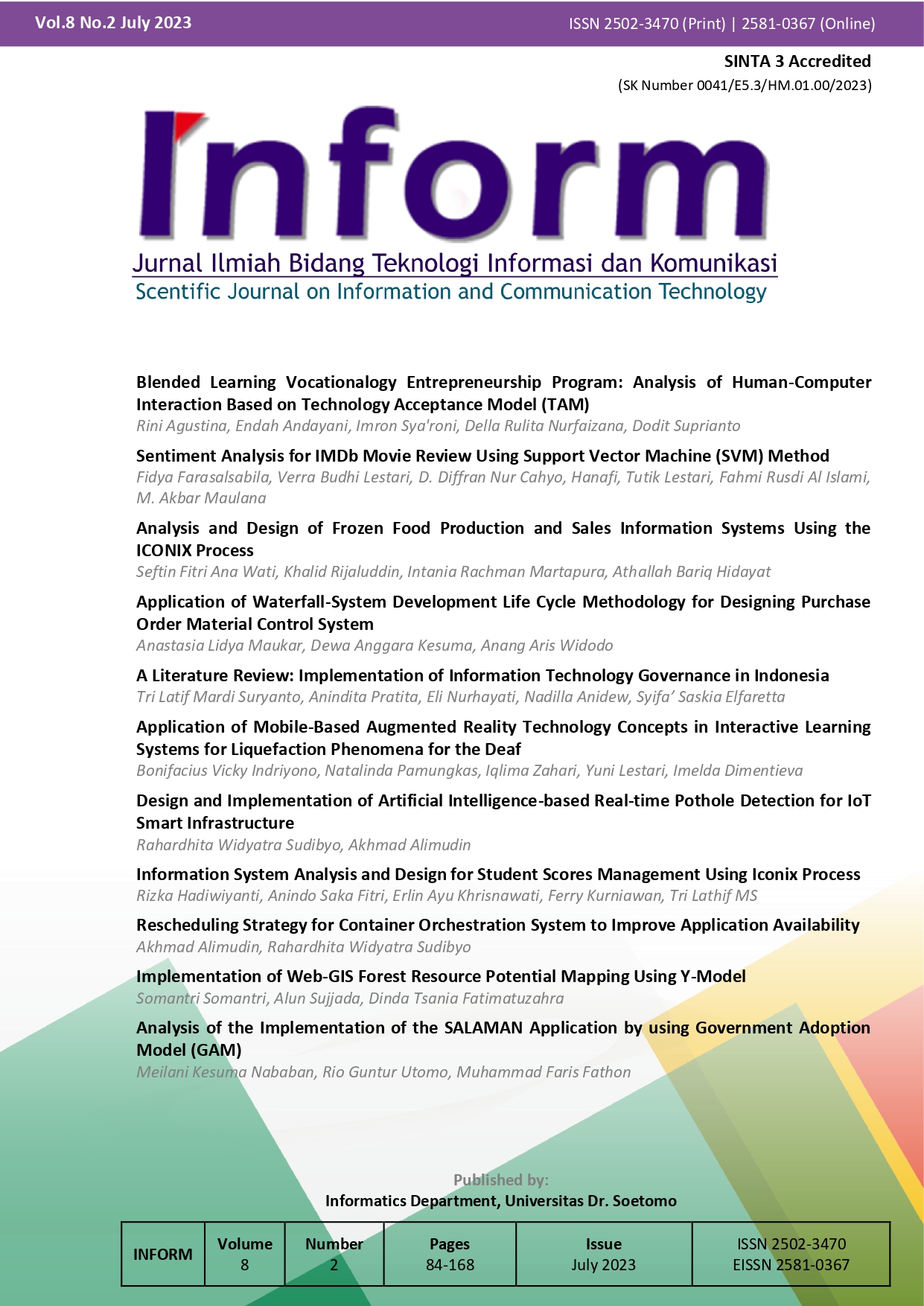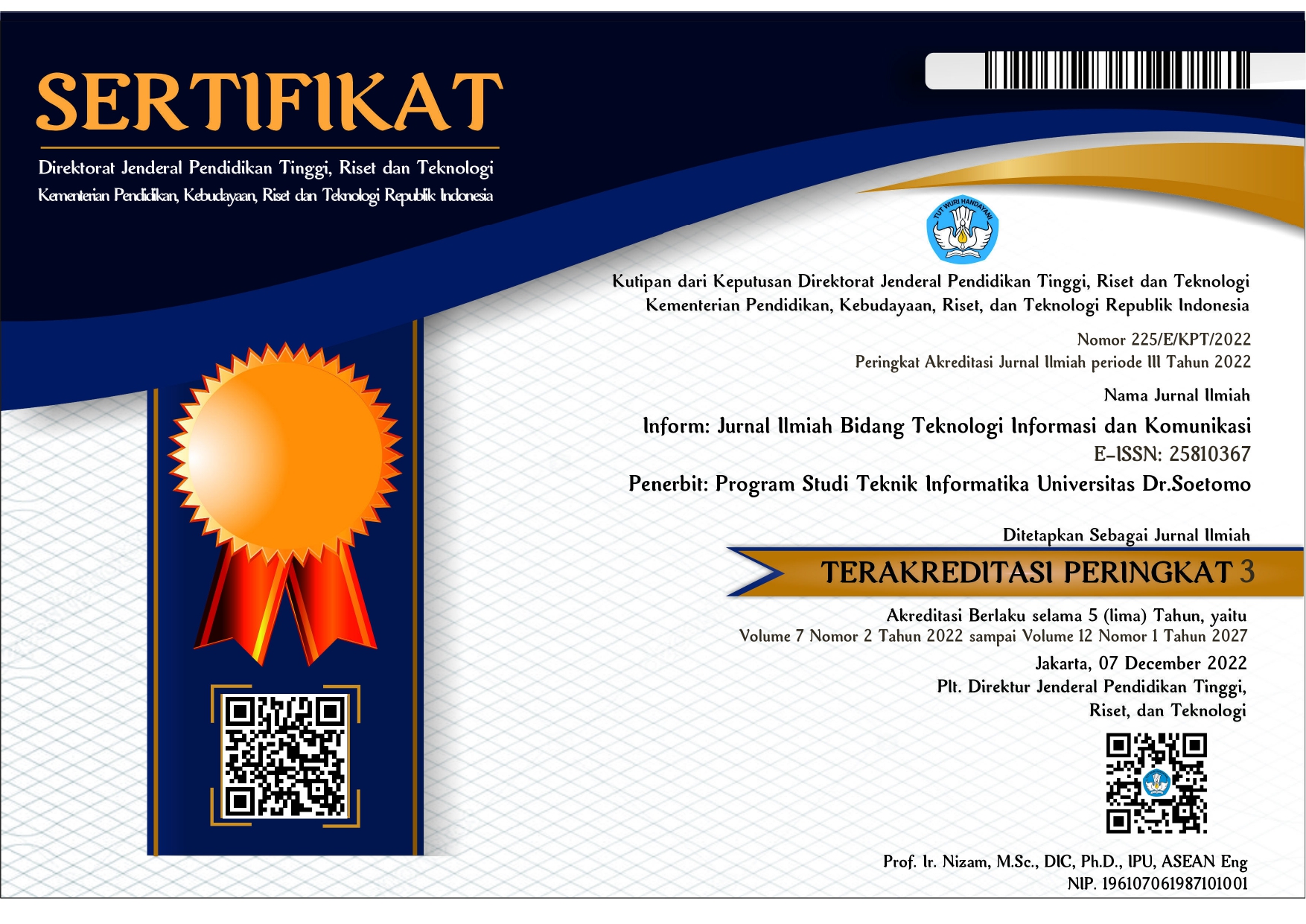Blended Learning Vocationalogy Entrepreneurship Program: Analysis of Human-Computer Interaction Based on Technology Acceptance Model (TAM)
 Abstract views: 332
,
Abstract views: 332
,
 PDF downloads: 400
PDF downloads: 400
Abstract
Blended learning is needed as a learning medium that can be used online, offline, asynchronously, or synchronously. The use of blended learning in entrepreneurship programs in vocational schools is intended to prevent learning loss in learning during the pandemic and post-pandemic. This study evaluates the results of developing web-based vocational media used as blended learning using the Technology Acceptance Model (TAM) measurement criteria. The measurement criteria include aspects of Perceived Usefulness (TPU) and aspects of Perceived Ease of Use (TPE), each of which has indicators of functionality (TFL), accessibility (TAC), and Computer Playfulness (TCP), which are then accumulated in the Behaviour Intention aspect (TBI). This evaluation study was analyzed using SEM (AMOS) and SPSS. A total of 121 class, XI SMK students were involved in collecting data in this research. Data was taken using a questionnaire consisting of 19 questions. The estimation results show that every aspect of TAM contributes quite well regarding vocationalogy media users. The evaluation results showed that 86.85% of users felt helped, liked, and found it easy when learning to use the vocationalogy media.
References
S. Kisno, "Pomodoro Technique For Improving Students' Reading Ability During COVID-19 Pandemic," J. Educ. Dev., vol. 8, no. 3, pp. 1–6, 2020.
U. Alturki and A. Aldraiweesh, "Application of Learning Management System (LMS) during the COVID-19 Pandemic: A Sustainable Acceptance Model of the Expansion Technology Approach," Sustain., vol. 13, no. 19, 2021, doi: 10.3390/su131910991.
M. Kuhfeld, J. Soland, B. Tarasawa, A. Johnson, E. Ruzek, and J. Liu, "Projecting the Potential Impact of COVID-19 School Closures on Academic Achievement," Educ. Res., vol. 49, no. 8, pp. 549–565, 2020.
K. Kisno et al., "Teachers’ Learning Loss Diminution Through Self-Phased Learning with Guru Binar,” Indones. J. Educ. Stud., vol. 24, no. 1, pp. 17–26, 2021.
Syahroni and Nurfitriyanti, “Pengembangan Media Pembelajaran Interaktif Berbasis Komputer dalam Pembelajaran Matematika,” Form. J. Ilm. Pendidik. MIPA, vol. 7, no. 3, pp. 262–271, 2017, doi: 10.30998/formatif.v7i3.2237.
R. Windawati and H. D. Koeswanti, “Pengembangan Game Edukasi Berbasis Android untuk Meningkatkan hassil Belajar Siswa di Sekolah Dasar,” J. Basicedu, vol. 5, no. 2, pp. 1027–1038, 2021, doi: 10.31004/basicedu.v5i2.835.
P. Sari, “Analisis Terhadap Kerucut Pengalaman Edgar Dale Dan Keragaman Dalam Memilih Media,” J. Manaj. Pendidik., vol. 1, no. 1, pp. 42–57, 2019.
A. Al-Aulamie, “Enhanced Technology Acceptance Model to Explain and Predict Learners’ Behavioural Intentions in Learning Management Systems,” University of Bedfordshire, 2013.
T. Irawati, E. Rimawati, and N. A. Pramesti, “Penggunaan Metode Technology Acceptance Model (TAM) Dalam Analisis Sistem Informasi Alista (Application Of Logistic And Supply Telkom Akses),” Account. Inf. Syst. Inf. Technol. Bus. Enterp. this is link OJS us, vol. 4, no. 2, pp. 106–120, 2020, doi: 10.34010/aisthebest.v4i02.2257.
R. Baki, B. Birgoren, and A. Aktepe, “A Meta Analysis of Factors Affecting Perceived Usefulness And Perceived Ease of Use in The Adoption of E-Learning Systems,” Turkish Online J. Distance Educ., vol. 19, no. 4, pp. 4–42, 2018, doi: 10.17718/tojde.471649.
P. Lai, “The Literature Review of Technology Adoption Models and Theories for the Novelty Technology,” J. Inf. Syst. Technol. Manag., vol. 14, no. 1, pp. 21–38, 2017, doi: 10.4301/s1807-17752017000100002.
R. Agustina, W. Kamdi, S. Hadi, Muladi, and D. Nurhadi, “Influence of the Principal’s Digital Leadership on the Reflective Practices of Vocational Teachers Mediated by Trust, Self Efficacy, and Work Engagement,” Int. J. Learn. Teach. Educ. Res., vol. 19, no. 11, pp. 24–40, 2020, doi: 10.26803/ijlter.19.11.2.
C. M. Chou, C. H. Shen, H. C. Hsiao, and T. C. Shen, “Factors Influencing Teachers’ Innovative Teaching Behaviour With Information And Communication Technology (ICT): The Mediator Role Of Organisational Innovation Climate,” Educ. Psychol., vol. 39, no. 1, pp. 65–85, 2019, doi: 10.1080/01443410.2018.1520201.
R. D. Susanto, R. Tjandinegara, V. Iskandar, and E. W. Kartika, “Technology Acceptance Model (Tam) Analysis of the Use of Ovo Application in F&B Service Industry in Indonesia,” J. Tour. Culin. Entrep., vol. 1, no. 1, pp. 1–14, 2021, doi: 10.37715/jtce.v1i1.1796.
S. A. Sivo, C. H. Ku, and P. Acharya, “Understanding How University Student Perceptions of Resources Affect Technology Acceptance in Online Learning Courses,” Australas. J. Educ. Technol., vol. 34, no. 4, pp. 72–91, 2018, doi: 10.14742/ajet.2806.
W. K. Bong, A. Bergland, and W. Chen, “Technology Acceptance and Quality of Life among Older People Using a TUI Application,” Int. J. Environ. Res. Public Health, vol. 16, no. 23, 2019, doi: 10.3390/ijerph16234706.
W. N. Syahril and B. Rikumahu, “Penggunaan Technology Acceptance Model (Tam) Dalam Analisis Minat Perilaku Penggunaan E-Money Pada Mahasiswa Universitas Telkom,” J. Mitra Manaj., vol. 3, no. 2, pp. 201–214, 2019, doi: 10.52160/ejmm.v3i2.201.
R. Agustina, D. Suprianto, and R. Ariyanto, “Technology Acceptance Model Analysis of User Behavioural Intentions on IoT Smart Board Devices,” 2021 1st Conf. Online Teach. Mob. Educ. OT4ME 2021, pp. 89–92, 2021, doi: 10.1109/OT4ME53559.2021.9638937.
T. Jap, “The Technology Acceptance Model of Online Game in Indonesian Adolescents,” Makara Hum. Behav. Stud. Asia, vol. 21, no. 1, p. 24, 2017, doi: 10.7454/mssh.v21i1.3497.
Copyright (c) 2023 Rini Agustina, Endah Andayani, Imron Sya'roni, Della Rulita Nurfaizana, Dodit Suprianto

This work is licensed under a Creative Commons Attribution-ShareAlike 4.0 International License.
Authors who publish with Inform: Jurnal Ilmiah Bidang Teknologi Informasi dan Komunikasi agree to the following terms:
-
Authors retain copyright and grant the journal right of first publication with the work simultaneously licensed under a Creative Commons Attribution License (CC BY-SA 4.0) that allows others to share the work with an acknowledgment of the work's authorship and initial publication in this journal.
-
Authors are able to enter into separate, additional contractual arrangements for the non-exclusive distribution of the journal's published version of the work (e.g., post it to an institutional repository or publish it in a book), with an acknowledgment of its initial publication in this journal.
-
Authors are permitted and encouraged to post their work online (e.g., in institutional repositories or on their website) prior to and during the submission process, as it can lead to productive exchanges, as well as earlier and greater citation of published work.











